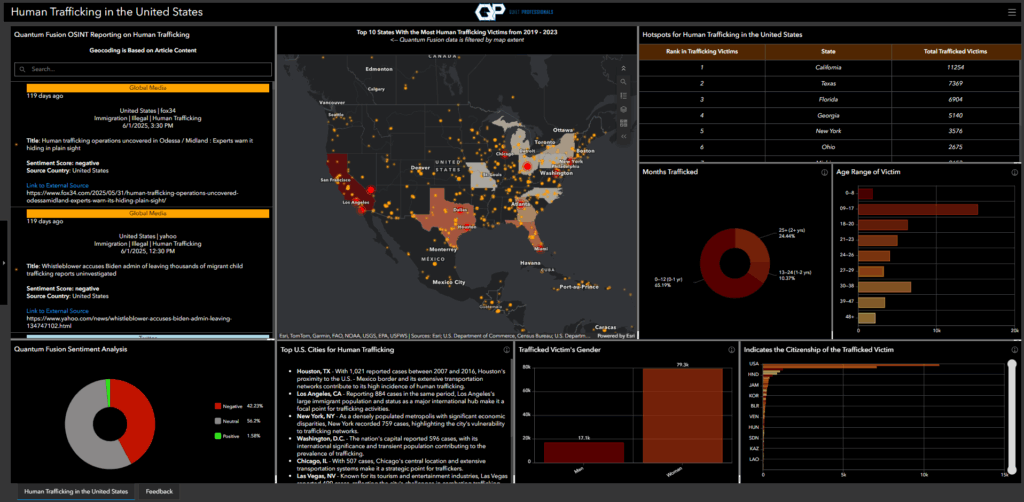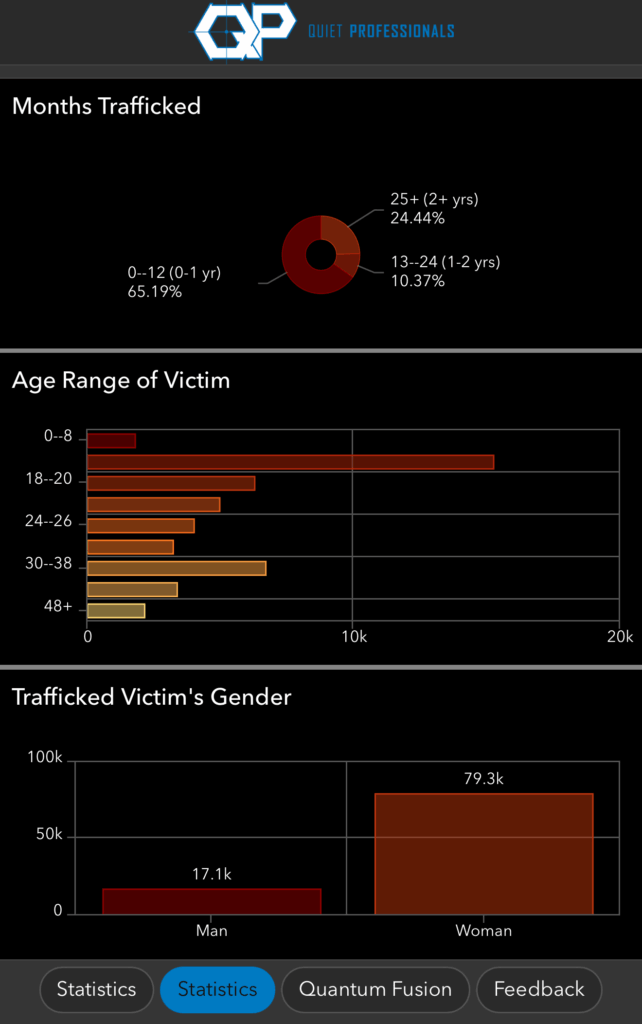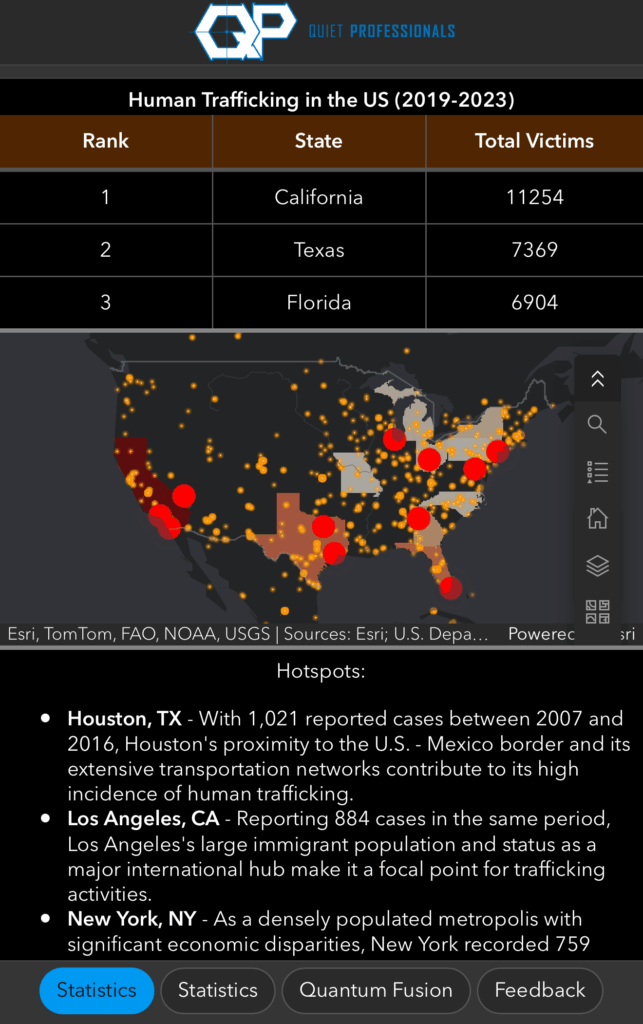Human trafficking leaves a devastating impact, but its patterns are often buried in scattered data and overlooked details. By pulling together what we do know, we can start to understand where it’s happening, who’s being affected, and how it continues.
This month’s OSINT report combines recent news coverage with data drawn from our public human trafficking dashboard. The dashboard includes reported trafficking patterns across the U.S. from 2019 to 2023, using anonymized victim data and geocoded reporting to highlight demographic trends and geographic hotspots. The OSINT summary below builds on this by analyzing current events gathered through the dashboard’s open-source feeds, offering a real-time look at how trafficking continues to unfold and evolve.
Dashboard Screenshots



OSINT Summary:
Human trafficking and migrant smuggling continue to rise across the U.S. and globally, fueled by profit, systemic neglect, and weak enforcement. A string of recent events highlights the human toll and the structural failures enabling these crimes. In San Diego, a boat suspected of being used for human smuggling capsized, killing three and injuring four. Among the missing are two children from an Indian family, part of a growing trend of migrants risking deadly sea routes to bypass land borders. This mirrors broader global patterns—2023 marked the deadliest year on record for irregular migration, with nearly 8,600 lives lost, primarily at sea. In the U.S., over 16,000 illicit massage parlors operate with little oversight, often exploiting middle-aged migrant women from China and Korea. Many are coerced into sex work through debt, deception, or force. Survivors report rape, emotional abuse, and living in squalid conditions. Yet state licensing boards rarely investigate, and law enforcement frequently fails to prosecute business owners or the criminal networks behind them. Instead, victims are often arrested, fined, or deported. Still, there are signs of progress. Georgia’s Human Trafficking Prosecution Unit has rescued over 200 children and achieved more than 50 convictions since 2019. Denver offers a model response—using financial investigations, licensing laws, and property enforcement to dismantle trafficking operations without re-traumatizing victims. Meanwhile, individual traffickers continue to be exposed: Two Venezuelan women received 30-year sentences for sexual exploitation; another case in Florida involved a man allegedly trafficking women for sex in exchange for drugs. In Tennessee, six men were charged after attempting to buy sex from undercover agents posing as minors. Experts say trafficking isn’t always visible—it often targets vulnerable people, especially teens and migrants, through manipulation rather than abduction. As enforcement lags and traffickers adapt, advocates stress the need for systemic reform: more aggressive oversight, stronger laws, and support services that treat survivors as victims—not criminals. To fight trafficking effectively, we must shift focus from punishing the exploited to dismantling the systems that exploit them.
Gender Distribution of Trafficked Victims:
The gender distribution of trafficked victims reveals a stark disparity between men and women. According to available data, the overwhelming majority of trafficking victims are women, with a total of 79,300 female victims reported. In contrast, the number of male victims is significantly lower, standing at 17,100. This gender gap highlights the vulnerability of women to human trafficking, particularly in contexts where sexual exploitation is prevalent. However, while women represent the larger portion of trafficked individuals, the data underscores that human trafficking impacts both genders, with men making up a notable segment of the victim population. This difference calls attention to the need for tailored support services that address the unique challenges faced by trafficked individuals of different genders
Age Range of Trafficked Victims:
The age distribution of trafficking victims further emphasizes the vulnerability of young people to exploitation. The youngest group, children aged 0-8, accounts for 1,800 victims, a harrowing statistic that underscores the severity of trafficking even at the earliest stages of life. The largest group of victims falls within the 9-17 age range, with 15,300 individuals, making this cohort the most at risk. This data suggests that minors, particularly teenagers, are highly susceptible to trafficking for purposes such as sexual exploitation and forced labor. Other age ranges, such as young adults aged 18-20 (6,300 victims) and individuals between 21-23 (5,000 victims), continue to see substantial numbers, indicating that trafficking persists well into adulthood. Although the frequency of trafficking decreases with age, the risk remains significant across all age groups, requiring continued vigilance and intervention efforts throughout a person’s lifespan
Duration of Trafficking:
The length of time victims spend in trafficking situations reveals important insights into the extent of their exploitation. A significant 65.19% of victims are trafficked for less than 12 months, suggesting that many individuals may experience shorter, albeit still traumatic, periods of exploitation. This could indicate a cycle of trafficking where individuals are trafficked temporarily and then re-trafficked, or that traffickers move victims frequently. A smaller portion, 10.37%, are trafficked for 13-24 months, while 24.44% are trafficked for over 25 months, indicating that a substantial number of individuals endure prolonged periods of abuse and captivity. These statistics highlight the need for both immediate and long-term support for survivors of trafficking, as well as systems in place to identify and assist individuals at different stages of exploitation
Geographic Hotspots for Human Trafficking in the United States:
Geographically, certain states in the United States experience disproportionately high numbers of trafficking victims, making them hotspots for such crimes. California ranks as the state with the highest number of trafficked victims, with a staggering 11,254 reported cases. Texas and Florida follow closely behind, with 7,369 and 6,904 victims, respectively. Other states with significant trafficking issues include Georgia (5,140 victims), New York (3,576 victims), and Ohio (2,675 victims). These numbers reflect both the size and the vulnerability of certain regions, where factors such as population density, tourism, economic disparity, and the prevalence of certain industries (like agriculture, entertainment, and construction) may contribute to the high rates of trafficking. The data underscores the need for targeted interventions in these regions, including law enforcement action, victim support services, and public awareness campaigns to reduce the prevalence of trafficking in these high-risk areas
OSINT Assessment/Recommendations:
Human trafficking remains a serious issue across the U.S., with many states struggling to find effective solutions. Traffickers often exploit weaknesses at ports and through visa systems, highlighting the need for tighter monitoring and more rigorous screening. Once in the country, victims—mostly women—are frequently trapped in debt and too afraid to seek help. QP THREAT recommends supporting nonprofits that aid survivors, removing penalties for those who come forward, and increasing penalties for the business leaders behind trafficking operations. Current leniency allows offenders to continue their crimes after short jail time or minor fines. Survivors who escape need full, consistent support to avoid falling back into trafficking, especially when fear of deportation prevents them from seeking help. Real change requires safe, consequence-free paths for victims to come forward and ongoing accountability for those who exploit them. Expect more parlors and sex trafficking to occur if there are no changes to the current enforcement/governance to the issue.
OSINT Assessment/Recommendations:
Human trafficking remains a serious issue across the U.S., with many states struggling to find effective solutions. Traffickers often exploit weaknesses at ports and through visa systems, highlighting the need for tighter monitoring and more rigorous screening. Once in the country, victims—mostly women—are frequently trapped in debt and too afraid to seek help. QP THREAT recommends supporting nonprofits that aid survivors, removing penalties for those who come forward, and increasing penalties for the business leaders behind trafficking operations. Current leniency allows offenders to continue their crimes after short jail time or minor fines. Survivors who escape need full, consistent support to avoid falling back into trafficking, especially when fear of deportation prevents them from seeking help. Real change requires safe, consequence-free paths for victims to come forward and ongoing accountability for those who exploit them. Expect more parlors and sex trafficking to occur if there are no changes to the current enforcement/governance to the issue.
Reports:
The reporting below is summarized. Full article links can be found in the sources section.
1.) 3 Dead as Migrants Boat Capsizes Off San Diego Coast
2 Indian Children Among Missing A boat carrying migrants, including an Indian family, capsized off the coast of San Diego, California, resulting in three deaths and four injuries. Seven people remain missing. The Indian family involved suffered greatly, with two children missing and the parents hospitalized. The Indian Consulate in San Francisco is assisting the family. The boat, a “panga” commonly used by smugglers, is suspected to have been involved in a human smuggling operation. Investigations are ongoing. This incident follows a similar 2023 tragedy in the same region, highlighting the growing trend of migrants using dangerous sea routes to bypass land border controls
2.) Two Venezuelan Women Accused of Human Trafficking
Two Venezuelan women accused of human trafficking and sexual exploitation given 30 years in prison
3.) Two Arrested for the Crime of Trafficking
Two arrested for the crime of trafficking in persons for the purpose of labor exploitation
4.) Georgia Expands Human Trafficking Unit to Macon
Since its launch in 2019, Georgia’s Human Trafficking Prosecution Unit has rescued over 200 children and secured more than 50 convictions with a 100% success rate. Now expanding beyond Atlanta, the unit has opened new offices in Macon and Augusta to better combat trafficking across the state. The Macon office is staffed with experienced local professionals familiar with the community. Officials say the region’s major interstates make it a hotspot for trafficking, a crime often misunderstood as involving kidnappings, when it more commonly targets vulnerable youths—especially runaways—aged 13 to 17. Georgia prosecutes both traffickers and buyers under strict laws, with a minimum 25-year sentence
5.) 5 Facts You Need to Know About Migrants Smuggling
The UNODC highlights migrant smuggling as a global, transnational crime driven by profit and fueled by a demand for irregular migration routes. Despite international efforts to curb it, smuggling persists across land, sea, and air routes, often with impunity. In 2023, nearly 8,600 people died during irregular migration—most notably by sea—making it the deadliest year on record. Smuggling is a multibillion-dollar industry, with smugglers exploiting vulnerable migrants through high fees and dangerous journeys. Though highly profitable, the crime often goes unpunished, with low-level operatives taking the fall while network leaders remain undetected. Migrants frequently face severe exploitation, including violence and trafficking, especially when stranded or indebted during their journey
6.) Man Arrested on Human Trafficking Charged in Hillsborough County
Deune Dukes, 38, was arrested in Hillsborough County, Florida, on April 1 after an undercover human trafficking investigation revealed he allegedly forced women to engage in sexual acts in exchange for drugs, using both drugs and violence to control them. Two victims were confirmed, with a third possible victim and a fourth woman reportedly being groomed. Dukes faces multiple charges including human trafficking, drug trafficking, and possession offenses, and had four outstanding warrants. Authorities emphasize their commitment to protecting victims and prosecuting traffickers. The investigation is ongoing, and support is being offered to survivors by the nonprofit Selah Freedom
7.) Six Men Facing Charges After Undercover Human Trafficking Sting in Morristown
Six men have been charged in Morristown, Tennessee, following a human trafficking sting conducted on May 2–3. Undercover agents posed as minors offering commercial sex, leading to the arrests. All six men face charges of trafficking for commercial sex acts, according to Hamblen County Court records
8.) At Least 16,000 U.S. Stores May Tied to Human Trafficking
A nationwide investigation by Lee Enterprises reveals that over 16,000 illicit massage parlors in the U.S. are potentially linked to human trafficking, often operating in plain sight with little oversight or legal consequence. These establishments—more numerous than McDonald’s—primarily exploit middle-aged migrant women from China and South Korea, many of whom are coerced into sex work under debt, manipulation, or misinformation. Despite clear signs of abuse and exploitation, most state licensing boards take minimal disciplinary action, and law enforcement rarely prosecutes traffickers or business owners. The investigation highlights systemic failures in regulation and enforcement, with only a small number of states actively cracking down on these illegal operations. Survivors describe a life of coercion, trauma, and limited choices, while traffickers operate with impunity, aided by lax laws and inadequate oversight
9.) Victims Often Punished as Human Trafficking Goes Unchecked
State massage licensing boards are ineffective, often passive and influenced by industry insiders, with most failing to investigate or discipline offending businesses. However, Denver stands out as a model for effective intervention—employing financial investigations, coordinated law enforcement, and licensing reform to dismantle trafficking rings and shut down illegal operations without re-traumatizing victims. The report underscores the urgent need for systemic change to disrupt the trafficking business model and truly support survivors
This report is built entirely from open-source and publicly available data, and yet the patterns are hard to ignore. Behind every data point is a person, a story, and a system that either failed them or helped them break free. Tools like this dashboard won’t solve the problem alone, but they can help. By making trends easier to see, we can help analysts, policymakers, and communities respond sooner, focus resources where they’re needed most, and better understand the conditions that allow trafficking to persist.
If this is what we can uncover using only public data, imagine what’s possible when combined with proprietary or classified sources. The more we connect, share, and act on information, the better our chances of disrupting trafficking at its root.
Sources
The Federal; 3 Dead as Migrants Boat Capsizes Off San Diego Coast; 2 Indian Children Among Missing; released on 06 MAY 2025; https://thefederal.com/category/international/two-indian-children-missing-migrant-boat-capsizes-san-diego-coast-185393
Omnia; Two Venezuelan Women Accused of Human Trafficking; released on 06 MAY 2025; https://www.omnia.com.mx/noticia/374979/dan-30-anos-de-prision-a-dos-venezolanas-acusadas-de-trata-de-personas-y-explota
El Ranca Guino Chile; Two Arrested for the Crime of Trafficking in Persons; released on 05 MAY 2025; https://www.elrancaguino.cl/2025/05/05/dos-detenidos-por-el-delito-de-trata-de-personas-con-fines-de-explotacion-laboral/
13 WMAZ; Georgia Expands Human Trafficking Unit to Macon; released on 05 MAY 2025; https://www.13wmaz.com/article/news/local/attorney-generals-office-expands-human-trafficking-prosecution-unit-central-georgia/93-5cacb017-cbcf-4d26-a295-cdeda765013a
UNODC; 5 Facts You Need to Know About Migrants Smuggling; released on 05 MAY 2025; https://www.unodc.org/unodc/en/frontpage/2024/December/5-facts-you-need-to-know-about-migrant-smuggling.html
WTSP; Man Arrested on Human Trafficking Charged in Hillsborough Count: released on 05 MAY 2025; https://www.wtsp.com/article/news/crime/human-trafficking-arrest-hillsborough-county/67-59e2834a-c3c8-40b0-9597-d73171425e91
Yahoo; Six Men Facing Charges After Undercover Human Trafficking Sting in Morristown; released on 05 MAY 2025; https://www.yahoo.com/news/six-men-facing-charges-undercover-181914698.html
Missoulian; At Least 16,000 U.S. Stores May Tied to Human Trafficking; released on 05 MAY 2025; https://missoulian.com/news/nation-world/crime-courts/article_e61eb4bf-1f63-5355-a139-8d030d2465c9.html
Winona Daily News; Victims Often Punished as Human Trafficking Goes Unchecked; released on 05 MAY 2025; https://winonadailynews.com/news/nation-world/crime-courts/article_118bf1bf-e7a7-5e43-b006-553709743c10.html
Quiet Professionals; Human Trafficking Dashboard